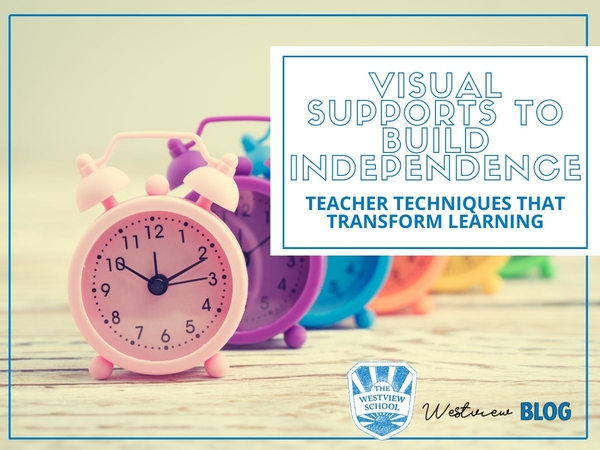
Visual Supports to Build Independence: Teacher Techniques That Transform Learning

At The Westview School, we believe that fostering independence is a cornerstone of helping children with autism thrive academically, socially, and emotionally. One of the most effective tools in this journey is the use of visual supports. Visual supports use images, symbols, or cues to help students process information, communicate clearly, and navigate their day. Some examples of this include picture schedules, checklists, social stories, timers, and task cards.
From managing daily routines to enhancing emotional regulation and problem-solving, visual supports empower students with confidence and autonomy. Westview teachers and administrators integrate these strategies into their classrooms every day. Each approach reflects the creativity and dedication of Westview staffers to ensure every student has the tools they need to succeed.
Morning Checklists: Starting the Day with Independence
Christine Reilly, Lower Elementary Teacher
Executive functioning skills, such as organization and time management, can be challenging for children with autism. Visual checklists provide a structured approach to these challenges. In Lower Elementary, students start their day with a visual checklist displayed on the board detailing morning expectations. For example, a picture of a backpack represents hanging it on a hook. As the year progresses, these picture prompts are gradually replaced with words, and eventually, students complete tasks independently without visual assistance.
"This approach not only creates a predictable environment but also reduces anxiety and fosters a sense of accomplishment," says Christine Reilly. "Students feel confident knowing they can take responsibility for their morning routine."
Transition Cues: Easing the Shift Between Activities
Trevie Stone, Lower School Physical Education Teacher
Transitions, particularly away from preferred activities, can be challenging for many students. Leaving the motor room can often be a tricky transition. Visual timers, such as the TimeTimer™, paired with verbal countdowns, help students understand the abstract concept of time.
"I might say, 'We have five minutes left. What would you like to do before we leave?'" explains Trevie Stone. "Picture cards are another helpful tool. A small picture of the next activity or location can be a tangible reminder, helping students anticipate what's next."
The physical setup of the environment also supports transitions. Designated line-up spots and shoe cubbies act as visual cues for students, creating a smooth and predictable flow from one activity to the next.
Innovative Visuals for Younger Students
Amanda Warley, Prekindergarten Teacher
In Prekindergarten, visuals are everywhere—on the walls, at tables, and in task instructions. Amanda Warley recently introduced a portable photo printer to create instant visual aids tailored to her students' needs. "If a student prefers blocks over trains, we can immediately update our visuals to reflect that," she shares.
Amanda also uses visuals to prepare students for new experiences. For example, before practicing for the holiday program in a different building, she printed a photo of the location. “Having a picture helps students process what to expect, reducing anxiety. These personalized visuals make all the difference in fostering understanding and comfort.”
Step-by-Step Task Cards: Building Independence in Learning
Serena Gaylor, Middle School Language Arts Teacher
Breaking down tasks into manageable steps fosters independence and encourages self-assessment. "In my classroom, students always have a 'to-do' list and an 'after I'm finished' list displayed on the screen," says Serena Gaylor.
Recently, during a poetry unit, students followed a criteria-based checklist to evaluate their work. "This allowed them to independently assess their poems, identify areas for improvement, and ask more specific questions," Serena explains. "Step-by-step guides give students the tools to take ownership of their learning and build confidence in their abilities."
Visual Supports for Emotional Regulation
Sally Schwartzel, Lower School Principal
Visual supports also play a vital role in helping students manage their emotions. Tools like visual schedules, checklists, and social narratives provide clarity and predictability, reducing anxiety. "When students know what to expect, they feel more in control of their day," says Sally Schwartzel.
For emotional regulation, visuals can help students identify their feelings and choose appropriate coping strategies. “If a student feels frustrated, visual supports remind them of what they can do—like taking deep breaths or asking for help. This empowers them to navigate challenging moments with greater confidence.”
Empowering Students Through Visual Supports
Visual supports are more than tools; they are bridges to independence, confidence, and self-advocacy. At The Westview School, we take pride in using evidence-based practices to meet our students' unique needs. By integrating creative and personalized strategies, our educators ensure that every child can shine in their own way.
Want to see these approaches in action? Visit our website or connect with us on Instagram and Facebook to learn more about how we are empowering our students every day.
